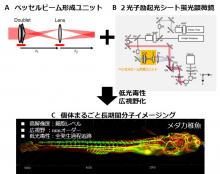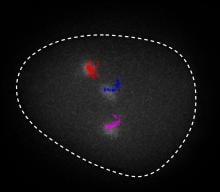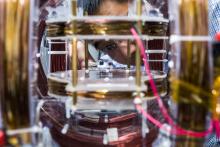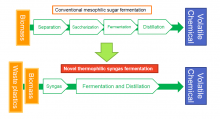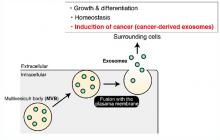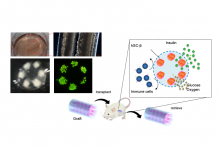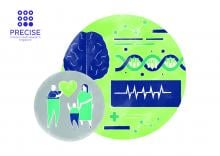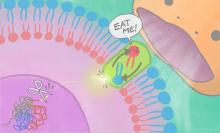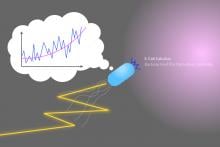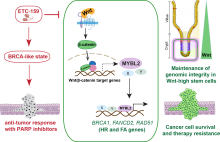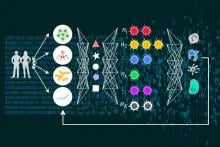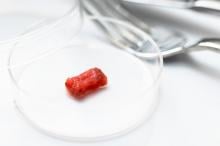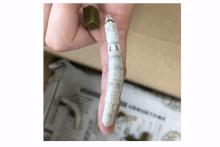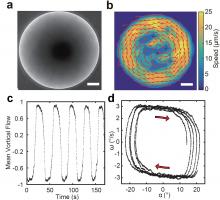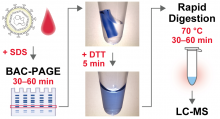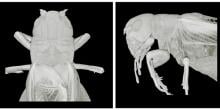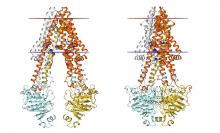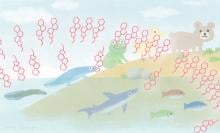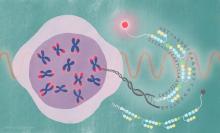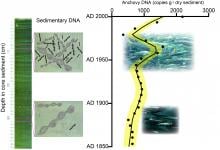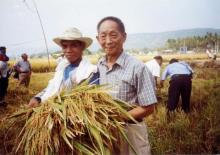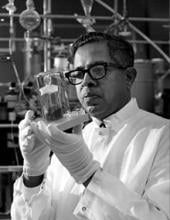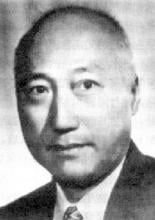Biotech
News
28 May 2021
Contributing to embryogenesis and pathogenesis through long-term in vivo molecular imaging
1. Development of a two-photon excitation light-sheet microscope which achieves low phototoxicity, an extended field of view, and high resolution for the observation of the growth of living organisms
2. Applications of the microscope demonstrate long-term time-lapse observations for a three-day span of the embryonic development of medaka fish
14 May 2021
Researchers have observed DNA spooling and unspooling in real time using CRISPR to attach fluorescent tags to very specific DNA points in living cells.
13 May 2021
A spray-on magnetic coat turns any object into a robot controlled by a magnetic field. The biocompatible robots can walk, crawl and roll, and switch motions on demand.
12 May 2021
Acetone, a volatile solvent used for everything from removing nail polish and cleaning textiles to manufacturing plastics, could get a sustainability boost from a new strain of bacteria engineered by a research team based in Japan.
07 May 2021
A group of researchers have discovered that the cells that line the surfaces of organs or specific tissues – epithelial cells – asymmetrically release two types of exomes with distinct protein compositions. Their discovery could help understand how cancer spreads.
07 May 2021
A new mouthwash developed in Malaysia, called Microencapsulated OroSYNTM, is expected to protect against oral diseases.
The mouthwash made from banana skin and a bacterium promotes a healthy microbiome in the oral cavity to protect against diseases

03 May 2021
A research team led by City University of Hong Kong (CityU) scientists recently developed a new generation of microneedles technology which allows the intradermal delivery of living cells in a minimally invasive manner. Their experiment showed that vaccination using therapeutic cells through this ground-breaking technology elicited robust immune responses against tumours in mice, paving the way for developing an easy-to-use cell therapy and other therapeutics against cancers and other diseases.

15 Apr 2021
Triple-negative breast cancer (TNBC) is an aggressive type of breast cancer with a high fatality rate. Currently, chemotherapy is the major treatment option, but the clinical result is unsatisfactory. A research team led by biologists at City University of Hong Kong (CityU) has identified and characterised a set of specific super-enhancers that stimulate the activity of the related critical cancer genes. The research has also discovered that the deletion of certain specific super-enhancers could reduce tumour cell growth. The latest findings may help discover new effective drug targets for TNBC patients to improve their survival chance.
15 Apr 2021
Researchers from The University of Tokyo develop a novel device for the safe and effective transplantation of human induced pluripotent stem cell (iPSC)-derived pancreatic beta-cells in type I diabetes mellitus
07 Apr 2021
New national body established to further research insights, improve patient outcomes and create new economic opportunities for the biomedical technology industry.
26 Mar 2021
An ‘eat-me’ signal displayed on cell surfaces requires activation of a lipid-scrambling protein by a nuclear protein fragment.
23 Mar 2021
The University of Tokyo researchers use information theory to show that the accepted biochemical model of bacterial chemical sensing is mathematically equivalent to the optimal solution, with implications for microbiology and robotics
16 Mar 2021
New research from Duke-NUS Medical School, and the Agency for Science, Technology and Research identifies chemotherapy-resistant cancers’ escape mechanism, which offers new anti-cancer treatment options.
10 Mar 2021
Researchers at The University of Tokyo use the mathematics of adaptive learning and artificial intelligence to describe how T helper cells adjust the response of the vertebrate immune system, which may lead to new vaccines and treatments for infections
02 Mar 2021
Researchers at The University of Tokyo develop a method of culturing meat in the laboratory in the form of millimeter-scale contractile beef muscle that closely simulates steak meat
26 Feb 2021
Tohoku University Researchers tweaked the diet of silkworms by adding cellulose nanofiber to their food. The resultant silk was stronger and more durable. This new method of realizing cellulose nanofiber synthesized silk is a sustainable way to produce biomaterials.
19 Feb 2021
An international team led by Professor Yilin Wu, Associate Professor of the Department of Physics at The Chinese University of Hong Kong (CUHK) has made a novel conceptual advance in the field of active matter science. The team discovered a new route in which the self-organisation of active fluids in space and time can be controlled by a single material property called viscoelasticity. This new finding may pave the way for fabricating a new class of self-driven devices and materials, such as the ability to control the rhythmic movement of soft robots without relying on electronic circuits, and for the study of microbial physiology. It has been published in the scientific journal Nature.
19 Feb 2021
Undergraduate students explore a more efficient way to measure protein-containing vessels released by cells
18 Feb 2021
Polyacrylamide gel electrophoresis enables high-resolution separation of proteins extracted from biological samples, but it requires more than one day of pretreatment to recover the separated proteins trapped inside the gel for detection by mass spectrometry. BAC-DROP, our novel electrophoresis technology, uses a dissolvable form of polyacrylamide gel, which allows sample pretreatment to be completed in about 5 hours. The developed technology will enable the rapid diagnosis of viruses and disease protein markers.
17 Feb 2021
Researchers from DGIST have now found a way to keep living, wet cells viable in an ultra-high-vacuum environment, using graphene, allowing—like never before—accurate high-resolution visualization of the undistorted molecular structure and distribution of lipids in cell membranes. This could enhance our bioimaging abilities considerably, improving our understanding of mechanisms underlying complex diseases such as cancers and Alzheimer’s
21 Jan 2021
A team of scientists in Japan has developed a novel method to induce stem cell generation from the blood samples of dogs. Through this technique, the scientists hope to advance regenerative therapies in veterinary medicine. This would mean that, in the near future, veterinarians might be able to reverse conditions in dogs that were previously thought incurable.
19 Jan 2021
New ‘armoured’ T cells attack cancer without being suppressed by drugs given to transplant patients to avoid organ rejection.
15 Jan 2021
A research group compared how crickets adapt to limb removal, revealing more about adoptive locomotion and the mechanisms underpinning it.
28 Dec 2020
Investigations of a cellular protein have uncovered a possible link with schizophrenia.
28 Dec 2020
iCeMS scientists have revealed how a transporter protein twists and squeezes compounds out of cells, including chemotherapy drugs from some cancer cells.
23 Dec 2020
A transporter protein that regulates cell membrane cholesterol likely played an important role in vertebrate evolution, according to a review published by iCeMS researchers in the journal FEBS Letters.
16 Dec 2020
Daegu Gyeongbuk Institute of Science and Technology (DGIST) researchers gain deeper insight into a cell membrane channel, with potential implications for drug development.

25 Nov 2020
An easy way to make millirobots by coating objects with a glue-like magnetic spray was developed in a joint research led by a scientist from City University of Hong Kong (CityU). Driven by the magnetic field, the coated objects can crawl, walk, or roll on different surfaces. As the magnetic coating is biocompatible and can be disintegrated into powders when needed, this technology demonstrates the potential for biomedical applications, including catheter navigation and drug delivery.
19 Nov 2020
A repetitive DNA sequence that causes health risks when it malfunctions can now be watched inside living cells using a synthetic tool
10 Nov 2020
Far too little is known about the long-term dynamics of the abundance of most macro-organism species. We used sedimentary DNA technology to quantify marine fish DNA abundance in sediment sequences spanning the last 300 years. This study first shows the existence of fish DNA in the sequences and proves that fish abundance can be tracked using sedimentary DNA, highlighting the utility of sedimentary DNA for researchers to acquire lengthy records of macro-organism species abundance.
Events
Sorry, no events coming up for this topic.
Researchers
Sorry, no researchers coming up for this topic.
Giants in history
Pakistani botanist Azra Quraishi (22 September 1945 – 22 November 2002) is recognised for developing virus-free seed potatoes that increased potato production in Pakistan by an estimated five per cent.
Indian botanist Shipra Guha-Mukherjee (13 July 1938 – 15 September 2007) made a breakthrough discovery that enabled the genetic study of plants and, by extension, the development of improved varieties of rice, wheat, potatoes, and other crops.
Japanese chemist Takamine Jokichi (3 November 1854 – 22 July 1922) founded the Tokyo Artificial Fertilizer Company, where he isolated a starch-digesting enzyme (named takadiastase) from the fungus Aspergillus oryzae.
Filipina chemist María Orosa (29 November 1892–13 February 1945) fought malnutrition and food insecurity in the Philippines by devising over 700 culinary creations including Soyalac, a nutrient rich drink made from soybeans, and Darak, rice cookies packed with Vitamin B1, which could prevent beriberi disease caused by Vitamin B1 deficiency. She was also a partisan of the guerrilla movement resisting Japanese occupation during World War II, and died after being struck by shrapnel while working in her laboratory during the Battle of Manila.
Chinese biochemist Cao Tianqin (5 December 1920 – 8 January 1995) discovered the myosin light chain, a subunit of myosin, a protein crucial for muscle contraction.
In 1939, biochemist Kamala Sohonie (18 June 1911 – 28 June 1998) became the first woman to be accepted into the Indian Institute of Science (IISc).
Chinese agronomist Yuan Longping (7 September 1930 – 22 May 2021) developed the first varieties of the high-yield, hybrid rice that brought food security to multiple countries including China, which had been ravaged by food shortages as recently as the mid-20th century.
David T. Wong (born 1936) is a Hong Kong-born American neuroscientist who is best known for discovering the antidepressant drug fluoxetine, better known as Prozac.
Cyril Andrew Ponnamperuma (16 October 1923 – 20 December 1994) was a Sri Lankan chemist who was interested in the origins of life on Earth. His research in chemical evolution showed how inanimate molecules may have given rise to the building blocks of life – a process known as abiogenesis.
Osamu Shimomura (27 August 1928 – 19 October 2018) was a Japanese organic chemist and marine biologist who dedicated his career to understanding how organisms emitted light.
Janaki Ammal Edavalath Kakkat (4 November 1897 – 7 February 1984) was an Indian botanist who studied plant chromosomes and genetics.
Gopalasamudram Narayanan Ramachandran (8 October 1922 – 7 April 2001) is best known for developing the Ramachandran plot to understand the structure of short chains of amino acids, known as peptides.
Hsien Wu (24 November 1893 – 8 August 1959) is widely regarded as the founder of biochemistry and nutrition science in China. He was the first to propose that protein denaturation was caused by the unfolding of the protein, instead of chemical alteration.
Umetaro Suzuki (7 April 1874 – 20 September 1943) was a Japanese scientist best remembered for his research on beriberi, a disease caused by vitamin B1 deficiency, characterized by limb stiffness, paralysis and pain.
Maqsudul Alam (14 December 1954 – 20 December 2014) was a biologist from Bangladesh who is renowned for his research on genome sequencing
Barry Paw (29 August 1962 – 28 December 2017) was a biologist and oncologist who discovered several novel genes and their functions in red blood cells.
Gloria Lim (1930-2022) was a mycologist from Singapore who studied tropical fungi. One of the first students to attend University of Malaya when it was founded in 1949, she went on to become the first female Dean of the Faculty of Science at the University of Singapore.


